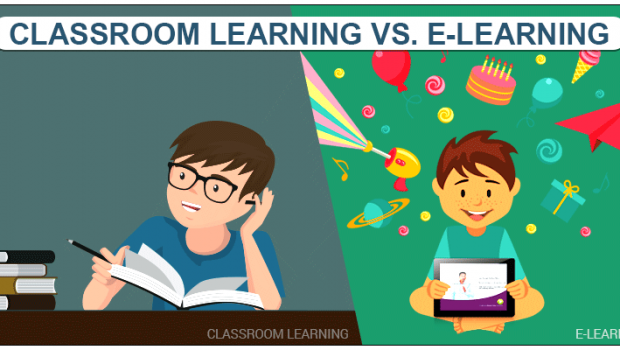E-Learning vs Classroom Learning
E-learning is a form of training or teaching that takes place over the internet or intranet. It is adapted from the computer based training of the early eighties which utilized CD-ROMs to distribute information to the users of a program. E-learning has become a widely used tool for teaching and training individuals in both academic and corporate settings. It is a convenient and inexpensive way to gain knowledge and information while pursuing higher learning. Companies can realize significant savings from transportation, room, board, and meals while sending employees through training programs. Also, many students are able to complete their educations because they can take courses when they have the time to do so. Classroom learning has more to do with reading through your NCERT books or textbooks in order to understand a subject.
There is an argument that traditional learning is the best way of maintaining a learning process. Other models are always considered to be inferior or less efficient. However, there is no finding to support this argument, and research shows that technology-supported models are at least as good as traditional learning. E-Learning includes many components that are familiar from traditional learning, such as: presentation of ideas by the students, group discussions, understanding NCERT Solutions, arguments and many other forms of conveying information and accumulating knowledge. With the help of e-learning you can even do programmes like rn to bsn online.
Advantages of Classroom Learning
- Learning Process – The whole class is participates in the learning and there is almost no individual or group study.
- Classroom Discussions – The teacher usually talks more than the students.
- Emphases in the Learning Process – Instead of “how”; students learn “what” in the class. The teachers and students are busy completing the required subject matter syllabus. The students are involved in tasks set by the teacher instead of solving or inquiry education or solving problems.
- Subject Matter – The teacher conducts the lesson according to the study program and the existing curriculum.
- Teacher’s Role – The teacher is the authority.
- Motivation – The students’ motivation is low, and the subject matter is “distant” from them.
- Lesson Structure – The teacher dictates the structure of the lesson and the division of time.
- Location of Learning – The learning takes place within the classroom and the school.
Advantages of E-Learning
- Learning Process – Most of the learning process takes place in groups or by the individual student.
- Classroom Discussions – The student talks at least as much as or more than the teacher.
- Emphases in the Learning Process – Instead of “what”, students learn more about “how”; the learning includes research study which combines searching for and collecting information from web data banks and authorities on the communications network; the learning is better connected to the real world, the subject matter is richer and includes material in different formats.
- Subject Matter – The student participates in determining the subject matter; the studying is based on various sources of information, including web data banks and net-experts located by the student.
- Teacher’s Role – The teacher directs the student to the information.
- Motivation – Motivation in the students is high mainly because of the involvement in matters that are close to technology.
- Lesson Structure – The structure of the lesson is affected by the group dynamics.
- Location of Learning – There is no fixed location for learning.
















